2. Preliminary Divisions (218a-232b)
The fundamental dichotomy from which all the subsequent divisions proceed is between the art of production and the art of acquisition, and
[4] Moreover, as Guthrie 5.158 points out, in the final dichotomy the sophist is identified with the maker of contradictions rather than speeches, the reverse of what Plato's usual characterization of sophists (in the Gorgias, Protagoras , and Republic 1, for example) would lead us to expect.
it is remarkable that although the subsequent final division will locate the sophist under the form of production (265a), all but the last of the preliminary divisions find the sophist under the form of acquisition. Moreover, the latter, which alone tries to locate him within the productive rather than acquisitive arts, fails to discover the sophist at all (230e-231a), and precisely for that reason.
The stranger summarizes the results of these preliminary divisions at 231d-e. In the first division the sophist showed himself as "the paid hunter of rich young men, . . . second, as a kind of merchant [



The precise number of divisions is thus overtly ambiguous. In fact there are only four fundamentally different preliminary divisions of the sophist, and they systematically reflect the Republic's account of the sophist based on the tripartite soul. In order to avoid the numerical ambiguity, and to collapse the variations of merchant-retailer-vendor into one, I shall designate the four as A [= I], B [= II/III/IV], C [= V], and D [= VI].
The demonstration division of the Angler (218e-221c), which provides the model for the others, begins with the words, "Shall we consider him as having an art or as someone without an art but with some other power?" (219a). Implicitly, then, the division begins with the form of power (


The Angler division is followed by division A of the sophist (221c-223b), which recapitulates steps 5 and 6 of the Angler division, before
[6] The inaccuracies are noted also by Klein (PT ), Rosen (PS ), and Benardete.
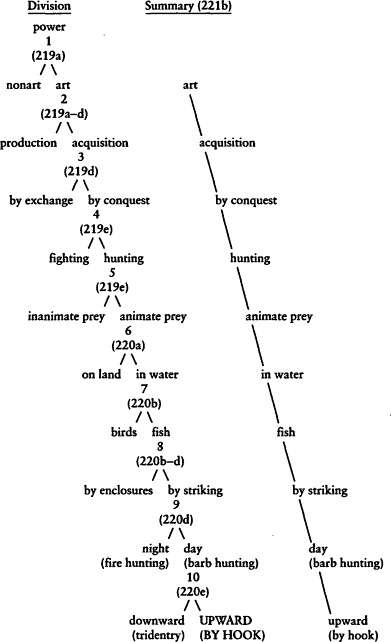
Figure 3
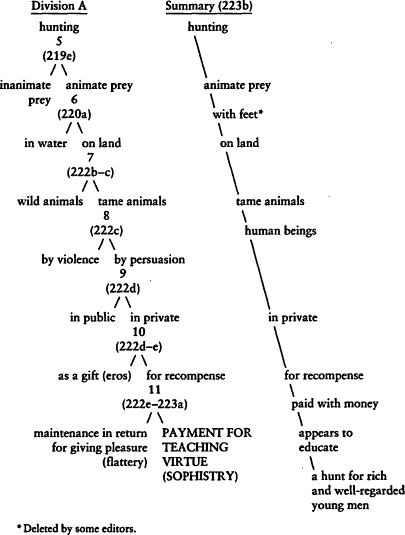
Figure 4
taking its own departure from 6a (see Figure 4). Although the summary is more explicit than the division in some places, it also drops one (and only one) of the division's steps, the distinction between persuasion and violence in step 8, and thereby the distinction between reason and spiritedness. We shall return to this point later.
The third subdivision of the Angler (exchange/conquest) corresponds
to the Republic's distinction between the commercial and spirited alternatives to reason. Accordingly, the fact that the first division of the sophist begins on the side of conquest suggests that we are here looking at him under his spirited aspect. But this is somewhat moderated by the next subdivision, step 5, which casts him in the role of a hunter rather than a fighter. Since a hunter aims at providing himself with sustenance, hunting makes reference to the appetitive as well as to the spirited side of our nature.[7] The stranger's description of this sophist as "the paid hunter of rich young men" (231d) combines both the attributes of commerce and aggression. Where this first division incorporates the spirited and appetitive elements jointly in its starting point, the starting points of divisions B and C will present each one separately.
Division B follows immediately, beginning under the heading of exchange, that is, subdivision 3a under Angler (see Figure 5). Here again the summary omits precisely one of the original steps, namely, step 5 (there is also a difference in the wording of step 8), the distinction between selling one's own products and those produced by someone else. The collapsing of that distinction implies that a sophist may be a merchant of his own products, which completes the symmetry: merchant of someone else's products (division II), retailer of his own products (division III), and retailer of someone else's products (division IV). Moreover, it implies that what matters is not whether he is productive, but that he is mercenary. In this appearance the sophist is guided exclusively by appetitive motives. He is out to make money by selling his knowledge of virtue.
The implicit symmetry mentioned above is made explicit when the stranger suggests that the sophist need not travel (224d), and might therefore be a retailer (6a) rather than a merchant (6b), and (224e) that he might make his own products (5a) rather than selling someone else's (5b). If these alternatives had been pursued, they would have yielded three more divisions (all variants on the appetitive aspect of the sophist). But they are not pursued, and Theaetetus, as we saw, counts this in one place as one more division (225e) and in another place as two (231d). He might equally have counted it as three (as the discrepancy between the division and the summary implied above), or as none, since all are minor variations on the preceding one. The introduction of so many variations emphasizes that the crucial point is the selling, not the
[7] In the Republic , hunters enter the city (373b) only when the formerly healthy, basic polis becomes feverish (372e) and begins to change from an agrarian (appetitive) society to a warrior (spirited) one (373d-e).
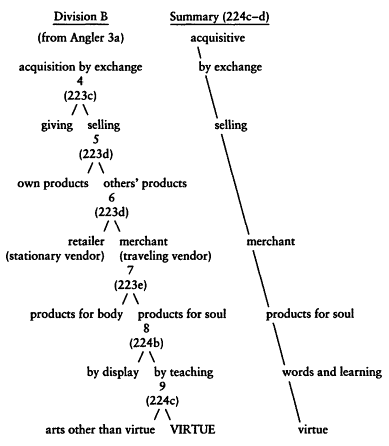
Figure 5
further distinctions under 5 and 6. The point common to them all is the restriction of sophistry to commerce, which is reflected later in the stranger's description of this group as showing the sophist to be a merchant or retailer (231d-e).
After this comes division C, which begins with species 4a under Angler (fighting), although the summary begins with division 2b (acquisition). The italics indicate where the initial steps are recalled from the Angler division in accordance with (although in more detail than) the summary (see Figure 6). Once again, a single step is omitted from the summary, namely, the distinction in step 3 between exchange and conquest.
Here it is the spirited element that is isolated as the starting point. "Fighting" rather than "hunting" leaves no doubt that only the spirited
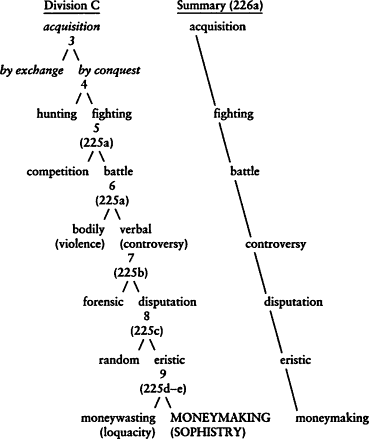
Figure 6
element is initially considered. The spirited nature of this aspect of the sophist is confirmed by the stranger's summary of the present division, which reveals the sophist to be "an athlete in contests of words, who has appropriated the eristic art" (231d-e). Nevertheless the final distinction is between moneywasting and moneymaking, which suggests that even at his most spirited the sophist is never entirely free of mercenary motives—a point that is emphasized by the summary's implicit collapsing of the exchange/conquest distinction, and its addition of the prior category of "acquisition." By contrast, in the case of the specifically appetitive sophist of division B, no spirited factors entered at all.
The Republic's third element, reason, is present in all three divisions,
but always in the role of a means to an end, rather than an end in itself or point of departure. In division A it appears in the form of persuasion (8b), which the sophist as hunter uses in lieu of violence to catch his prey. Its subordinate role is emphasized even more in the summary, which omits the distinction in step 8 between persuasion and violence. In division B it appears among the works that serve the soul rather than the body (7b), particularly those concerned with virtue (9b), which are sold by the sophist as retailer or as merchant. And in division C it appears as the verbal rather than physical weapons that are employed by the sophist as fighter (6b). In each case reason is subordinated to appetite or spiritedness, and the three cases correspond to the two types of injustice, and their combination, which are developed in the Republic and illustrated in the person of Thrasymachus.
Division D, which follows, is the only one in the dialogue (including the final one) that does not follow from the Angler division, and the only one that follows from a preliminary "collection," in accordance with the way the method is described in the Phaedrus (265c-266b).[8] The stranger surveys various types of tasks performed by servants (226b-c), the common denominator of which is that they all involve an act of division (


Here we do not find the sophist (or any discrepancy in the summary). What we find is a species about which the stranger says, "I'm afraid to say [these are] sophists . . . lest we accord to them too great an honor"; they resemble sophists, but only as the dog resembles a wolf (231a). He calls this species instead "noble sophistry" (231b). The "noble sophist" is generally recognized to be a reference to Socrates (cf. 230a-d), and the general form from which the division begins, "discrimination" or "division" (

[8] Socrates' opening remark in the Sophist , that the stranger may be a god in disguise (216a), is perhaps meant to remind us of the Phaedrus , where someone who is able to perform collections and divisions properly is compared to a god (266b).
[9] The belief that ignorance is never voluntary, is held not only by both the noble sophist and Socrates, but by the stranger as well (228c).
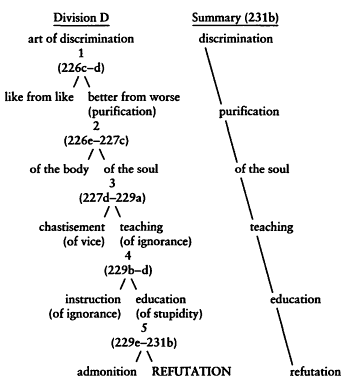
Figure 7
irrational parts of the soul, and when we confine ourselves to the soul's purely rational operations, we do not find the sophist. If we think in terms of appetite (division B), or spiritedness (division C), or both together (division A), we will find the sophist, but if we confine ourselves to rational discrimination alone (division D), we will not.
The most direct reference to the tripartite soul occurs in division D, step 3, when the stranger draws a distinction between chastisement, which corrects vice, and teaching, which corrects ignorance (227d-e). The difference between vice and ignorance is that ignorance, like deformity in the body, is a kind of missing of the mark, whereas vice, like disease in the body, is a kind of disharmoniousness.[10] The latter is in
[10] The distinction turns out to be less absolute than it seems at first. At 230c the stranger compares one aspect of the instruction that corrects the soul's ignorance to the practice of physicians. This draws an implicit connection between ignorance and disease, whereas previously ignorance was connected with deformity, and vice with disease. The implication is that even though ignorance is no longer conceived as a necessary condition for vice (as it was by Socrates), it is still conceived as a sufficient condition. Someone with the wrong ideas about goodness will not be virtuous, even though the right ideas are no guarantee of virtue either. For a perceptive and carefully annotated discussion of this passage, see Paul Gooch, "'Vice Is Ignorance': The Interpretation of Sophist 226A-231B," Phoenix 25 (1971) 124-33.
fact the definition of vice (injustice) given in Republic 4 in terms of the tripartite soul—both as disharmony (444b) and disease (444c-e). Moreover, during the discussion of vice the stranger remarks, "In the souls of people who are in a worthless condition, do we not see opinions opposed to appetites [



Even the distinction between ignorance and vice already implied the tripartite soul. The Socrates of the early dialogues had equated virtue with knowledge, and thereby vice with ignorance. But these equations could not explain what Aristotle later called moral weakness (

[11] All this means that the opening divisions have more substantial importance than is generally recognized. What importance they are usually thought to have is limited to their exhibition of diversity. For Taylor 381 they are meant to show that the sophist is the one who "can masquerade in all these guises" and is accordingly "a pitter of discourse against discourse, a contradiction-monger." For Cornford (PTK 187), "the first six Divisions actually, though not formally, serve the purpose of a Collection preliminary to the seventh," a view shared by Sayre (PAM 154-55), except that for him "the first five Sophists serve as a collection for the seventh, and . . . the definition of 'Sophist VI' illustrates the way in which a common property is to be sought." Other writers such as Friedländer, Rosen, and Benardete take the details of the opening divisions more seriously and find much of interest to say about them, although they do not see the divisions as embodying an underlying pattern.
The fact that the Sophist does retain—even if only implicitly—the doctrine of the tripartite soul makes more interesting the question why Plato now abandons his former practice of using this model in order to distinguish philosophy from sophistry. All the more so, because the distinction that he draws between them at the end of the dialogue, without that model, proves to be unsatisfactory.